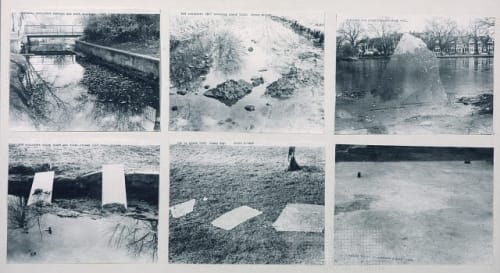Decay as a Statement: The Rise of Ephemeral Art
By Joseph Jenkinson
As climate collapse looms and our materials grow suspect, a new generation of artists embraces disappearance over durability.
In an age increasingly defined by the detritus of human impact, a growing cohort of artists are abandoning the pursuit of permanence altogether. Instead, they are turning to the fugitive, the unstable, and the biodegradable—works made to disintegrate, melt, fade or fall apart. Ephemeral art, far from being a resignation to loss, offers a radical meditation on time, nature, and our place within both.
“To understand the land, I have to understand the wind, the snow, the rain…”
— Andy Goldsworthy
This shift toward impermanence arrives within the broader context of the Sustainable Art movement, which seeks to reimagine artistic production beyond extractive materials. But where some attempt to replace oil paints with natural dyes, ephemeral artists challenge the very notion of longevity as a virtue. Their work, made from flowers, sand, ice, or even salt, is built to vanish.
Rethinking the Anthropocene
The Anthropocene—our current ecological epoch shaped by human intervention—has cast a long shadow over artistic practice. Though its precise origins are debated, many trace its roots to the Industrial Revolution, with its fossil fuels, smokestacks and hunger for permanence. In response, art of the Romantic period often reflected a sense of awe tinged with ecological anxiety.
Caspar David Friedrich’s Wanderer above the Sea of Fog (1818), depicting a lone figure gazing across a misty expanse, is emblematic of that moment. The man, back turned to the viewer, is both witness and warning—small against the scale of nature, and unable to control it.
If art once functioned as a monument to endurance, ephemeral art now speaks to flux. It questions whether durability still holds any moral or aesthetic weight in a world shaped by disappearance.
What Is Ephemeral Art?
The term ‘ephemeral’ comes from the Greek ephēmeros, meaning “lasting only a day.” The materials used—leaves, salt, melting ice—reflect that transience. These works are often staged outdoors, exposed to the very elements that will slowly erase them.
The movement gained traction in the 1960s with Fluxus, whose artists resisted the gallery system in favour of experience-based works that held no commercial value. The point wasn’t preservation. It was presence.
“It’s not anti-art or anti-permanence. But things die. That’s just the nature of things.”
— Andy Goldsworthy
Bruce McLean
Six Sculptures (1967–68)
In a series of photographs now held by Tate, British artist Bruce McLean documents temporary sculptures constructed from found materials. The works no longer exist. Only the images remain—a quiet meditation on time’s inevitable passage.
Forms of the Temporary
Ephemeral art resists stylistic unity, spreading across various disciplines:
-
Land Art: Site-specific structures shaped by and for the landscape—stone spirals, twig mandalas, soil installations—designed to degrade.
-
Installation Art: Immersive works often built from fragile or impermanent materials, meant to be experienced rather than owned.
-
Performance Art: Where the artist’s body becomes the medium. The work lives only in the moment of its making.
-
Conceptual Art: Works that may exist solely as documentation, sketch, or idea. The process outweighs the product.
Though the aesthetics vary, the core impulse remains: to subvert permanence, and to align art more closely with life’s own rhythms.
Digital Ephemerality
In the digital era, some artists have turned to technology not to archive, but to intensify the fleeting. American conceptual artist Jenny Holzer projects text-based works onto the facades of city buildings—brief, monumental flashes of light, gone by morning. The work resists collection, refuses commodification, and lives only in memory.
Notable Artists
Cecilia Vicuña
The Chilean poet and artist uses unspun wool, water, and organic matter to create installations that decay over time—tactile, slow-burning elegies to memory and erosion.
Motoi Yamamoto
His floor-bound salt drawings—dismantled and returned to the ocean—echo Japanese rituals of mourning. What begins as an intricate form ends in dispersion, reinforcing the cyclical rather than the fixed.
“Without a time-travelling DeLorean, we can’t return to the moment. The work lives, and then it’s gone.”
Andy Goldsworthy
Ice Arch (1982), Ice Ball (1985), Touching North (1989)
Perhaps the most well-known practitioner of ephemeral art, Goldsworthy’s work is a collaboration with the forces that will ultimately destroy it. Whether crafting arches of ice or leaf mosaics, he photographs each piece in its prime, then lets nature take its course.
In a 2007 interview, he remarked:
“If I’m going to understand the land, I have to understand the wind, the snow, the rain… It just reflects a reality for me.”
Goldsworthy’s humility in the face of entropy is not melancholic, but revelatory. His work doesn’t mourn impermanence—it celebrates it.
Legacy in Disappearance
Ephemeral art is not a gesture of nihilism, but of deep ecological consciousness. As the climate crisis accelerates, these works remind us that value doesn’t lie in duration, but in awareness. That presence is its own kind of permanence.
If the Anthropocene is a reminder of human fragility, ephemeral art invites us to reconsider our relationship with time, memory, and the natural world. By embracing transience, artists call us to reflect on our role in the ongoing story of the planet—and challenge us to live more consciously within it.
All images courtesy of the artists and galleries.
